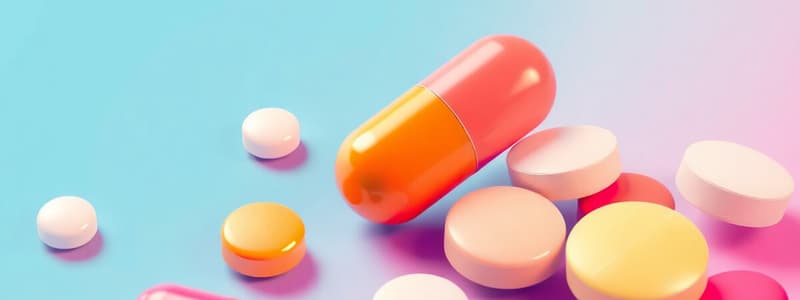Podcast
Questions and Answers
What does the term 'parenteral' specifically refer to in the context of drug administration?
What does the term 'parenteral' specifically refer to in the context of drug administration?
- Oral routes of administration
- Topical application for skin treatment
- Injectable routes of administration (correct)
- Non-invasive drug delivery systems
Which scenario best exemplifies when parenteral administration is preferable?
Which scenario best exemplifies when parenteral administration is preferable?
- When a patient can tolerate oral medication
- When the drug has a high oral bioavailability
- When a rapid drug action is desired during an emergency (correct)
- When the patient has a mild condition
Which type of drug delivery system is commonly used for administering drugs to the eye?
Which type of drug delivery system is commonly used for administering drugs to the eye?
- Sublingual sprays
- Solutions and suspensions applied topically (correct)
- Inhalation aerosols
- Oral tablets
Why are formulations like gels often utilized in ophthalmic drug delivery?
Why are formulations like gels often utilized in ophthalmic drug delivery?
What is the typical volume of tear fluid retained in the cul-de-sac of the human eye?
What is the typical volume of tear fluid retained in the cul-de-sac of the human eye?
Which of the following is NOT a characteristic of aerosol drug delivery for respiratory functions?
Which of the following is NOT a characteristic of aerosol drug delivery for respiratory functions?
What is a key advantage of inhalation as a route for drug delivery?
What is a key advantage of inhalation as a route for drug delivery?
Which statement about pyrogens is correct?
Which statement about pyrogens is correct?
What distinguishes granules from powders?
What distinguishes granules from powders?
What type of shell is commonly used for capsules?
What type of shell is commonly used for capsules?
What is a primary characteristic of effervescent granules?
What is a primary characteristic of effervescent granules?
Which of the following correctly describes tablets?
Which of the following correctly describes tablets?
What process is involved in the preparation of granules using the wet method?
What process is involved in the preparation of granules using the wet method?
Which of the following statements is true regarding sterile dosage forms?
Which of the following statements is true regarding sterile dosage forms?
What is an important aspect of the composition of a good effervescent blend?
What is an important aspect of the composition of a good effervescent blend?
How can the physical state of a 'powder' be described?
How can the physical state of a 'powder' be described?
Flashcards
Powders (Dosage Form)
Powders (Dosage Form)
A mixture of finely divided drugs or chemicals in dry form, used internally or externally.
Parenteral administration
Parenteral administration
Injectable routes of drug administration, outside the intestinal tract (other than oral)
Granules (Dosage Form)
Granules (Dosage Form)
Irregular-shaped agglomerates of smaller particles that act as larger particles, often prepared by a wet method.
Pyrogens
Pyrogens
Signup and view all the flashcards
Effervescent Granules
Effervescent Granules
Signup and view all the flashcards
Ophthalmic drug delivery
Ophthalmic drug delivery
Signup and view all the flashcards
Capsules (Dosage Form)
Capsules (Dosage Form)
Signup and view all the flashcards
Tear fluid volume
Tear fluid volume
Signup and view all the flashcards
Tablets (Dosage Form)
Tablets (Dosage Form)
Signup and view all the flashcards
Ophthalmic drop volume
Ophthalmic drop volume
Signup and view all the flashcards
Parenteral Preparations
Parenteral Preparations
Signup and view all the flashcards
Aerosol drug delivery
Aerosol drug delivery
Signup and view all the flashcards
Rapid drug action
Rapid drug action
Signup and view all the flashcards
Wet method for Granule Production
Wet method for Granule Production
Signup and view all the flashcards
Solid Dosage Forms
Solid Dosage Forms
Signup and view all the flashcards
Ophthalmic gel
Ophthalmic gel
Signup and view all the flashcards
Study Notes
Solid Dosage Forms
- Powders (pulvis) are mixtures of finely divided drugs or chemicals in a dry form.
- They can be used internally or externally.
- "Powders" is a dosage form.
- "Powder" describes the physical state of a single chemical or drug.
- Powders may contain: small amounts of liquids dispersed over the solid components, or only solid materials.
Granules
- Granules are irregularly shaped agglomerates of smaller particles that behave like single larger particles.
- Granules can be prepared by various methods.
- The wet method involves: moistening the desired powder or powder mixture, passing the moistened mass through a mesh screen to produce granules of the desired size, drying the granules (by air or heat, considering drug sensitivity to heat), and occasionally moving them on drying trays to prevent sticking.
Effervescent Granules
- Special granules used to mask bitter or salty tastes in selected drugs.
- They create a numbing sensation on taste buds.
- Made of mixtures, often citric acid, tartaric acid combined with sodium bicarbonate.
- A good blend typically uses a 1:2 ratio of citric and tartaric acid.
Capsules
- Solid dosage forms enclosing one or more medicinal substances within a shell.
- Usually prepared from gelatin.
- Gelatin shells can be hard or soft.
Tablets
- Solid dosage forms of medicinal substances, often made with pharmaceutical additives.
- Vary in size, shape, weight, hardness, and thickness, depending on intended use and manufacturing methods.
- Most tablets are for oral administration.
- Other tablets (e.g., sublingual, buccal, vaginal) may not use the same additives or properties as oral tablets.
Parenteral Preparations (Sterile Dosage Forms)
- Sterile, pyrogen-free preparations administered "parenterally" (outside the intestine; other than oral).
- Injectable routes of administration.
- "Parenteral" comes from Greek words "para" and "enteron," meaning "outside the intestine."
- "Pyrogens" are fever-producing organic substances from microbial contamination.
- Common applications include emergency situations needing rapid drug action, when patients can't tolerate other routes, or when other routes are ineffective.
- Insulin injections are often self-administered by diabetic patients.
Ophthalmic Drug Delivery
-
Drug delivery systems (solutions, suspensions, gels, ointments, inserts) applied topically to the eye.
-
Normal tear volume is approximately 7-8 µL retained in the eye's cul-de-sac.
-
A single ophthalmic drop (around 50 µL) is typically used, but much of the drop is lost.
-
Excessive liquid delivery will drain rapidly.
-
Recently developed micro-liter droppers allow for precise 5-10 µL dosing.
-
Ophthalmic gel formulations may extend corneal contact time, reduce dosing frequency, and improve drug absorption. (due to the dynamic lacrimal system)
Inhalations
-
Aerosol drug delivery is used to treat local respiratory conditions (such as asthma, pneumonia).
-
This delivery method enhances the systemic absorption of drugs with relatively low bioavailability.
-
Minimizes drug loss.
-
Targeted delivery systems avoid toxic effects from systemic administration.
Studying That Suits You
Use AI to generate personalized quizzes and flashcards to suit your learning preferences.




